Pennsylvania Secretaries of Transportation
This page features the secretaries who served during PennDOT's first 50 years.
 Secretary Yassmin Gramian
Secretary Yassmin Gramian
2020 to 2023
Yassmin Gramian, PE, was confirmed unanimously by the Senate on May 27, 2020. She served until January 2023.
Secretary Leslie S. Richards
2015 to 2019
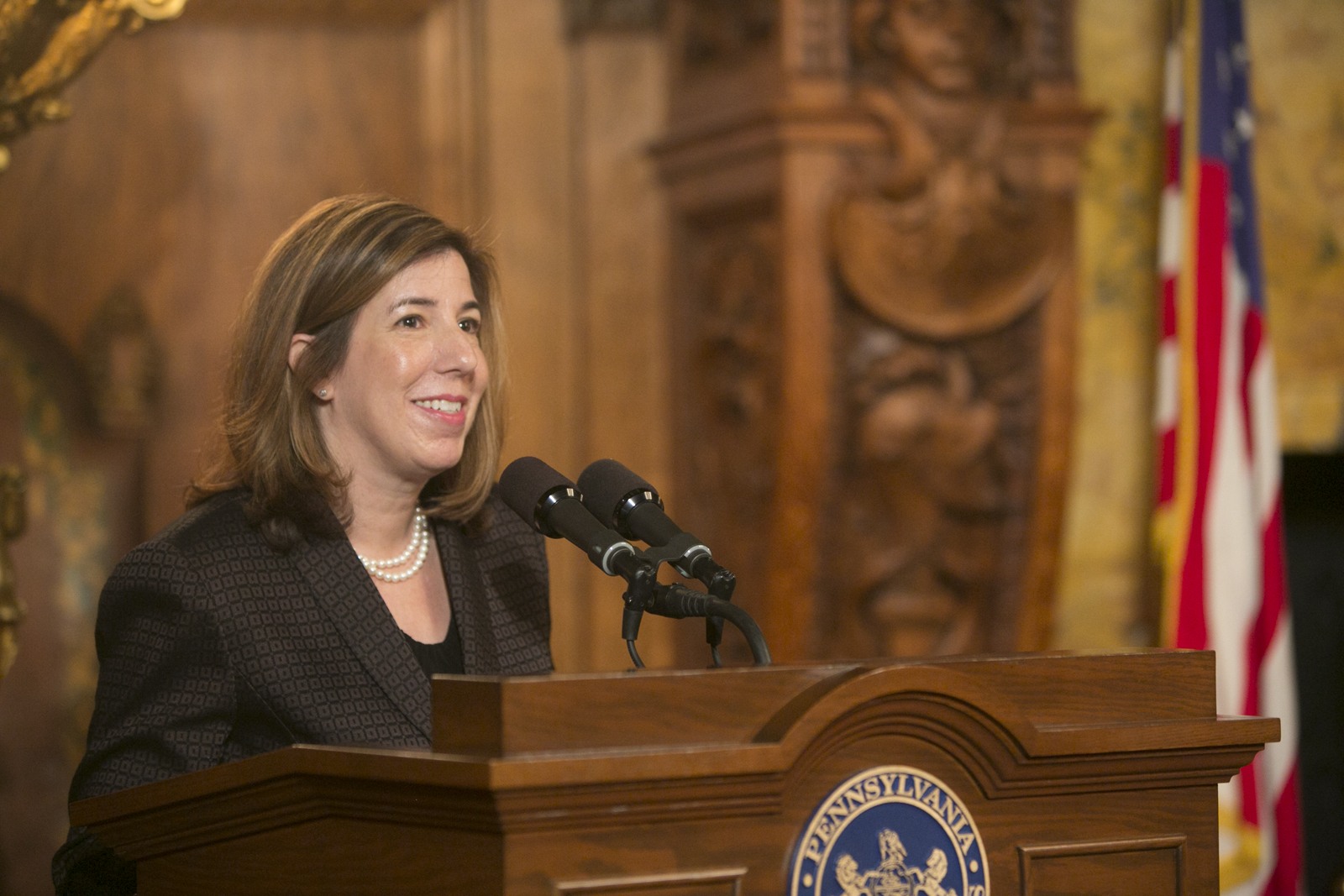 In 2015, Leslie Richards was the first woman appointed as a Secretary to PennDOT, but she paved the way for other females to succeed in the industry. Equity. Diversity. Inclusion. She spoke of these issues passionately. She improved the representation of women and minorities in management positions during her tenure. She created a Moving Women Forward program by holding sessions around the state targeted toward engineering and planning students as well as young women the field. Leslie and 2 or 3 other women in the field would tell their career stories and provide real world examples of successful women. Leslie's theme for these young women in their careers in a male dominated transportation industry was "You have to see one to be one."
In 2015, Leslie Richards was the first woman appointed as a Secretary to PennDOT, but she paved the way for other females to succeed in the industry. Equity. Diversity. Inclusion. She spoke of these issues passionately. She improved the representation of women and minorities in management positions during her tenure. She created a Moving Women Forward program by holding sessions around the state targeted toward engineering and planning students as well as young women the field. Leslie and 2 or 3 other women in the field would tell their career stories and provide real world examples of successful women. Leslie's theme for these young women in their careers in a male dominated transportation industry was "You have to see one to be one."
Leslie addressed funding early in her tenure where she led the charge on the growing fiscal impact of State Police funding on the motor license fund. She showed the legislature the inability of the department to address many of the Act 89 Decade of Investment list of projects without capping the amount going to PSP. Ultimately the legislature passed a cap that would be achieved over 10 years, and which would increase PennDOT's budget by over $2 billion. She then used those newly identified funds to allocate an additional $1 billion to construction for the 12 Year Program and $1 billion to county maintenance budgets allowing yearly increases reflecting the cap being achieved over 10 years. Funding issues regarding the existing and projected conditions of the interstates were addressed through a new policy where she directed that additional funding be directed toward interstate projects and a planning process started to explore targeted tolling of major bridges to generate additional critical funding for the interstates and the expressway system.
She also achieved a new focus on improved county maintenance practices through her County Accreditation program which focused on teaching the business of maintenance to the districts and counties. Significant savings were achieved by sharing and using best practices and using proper planning and scheduling of road treatments.
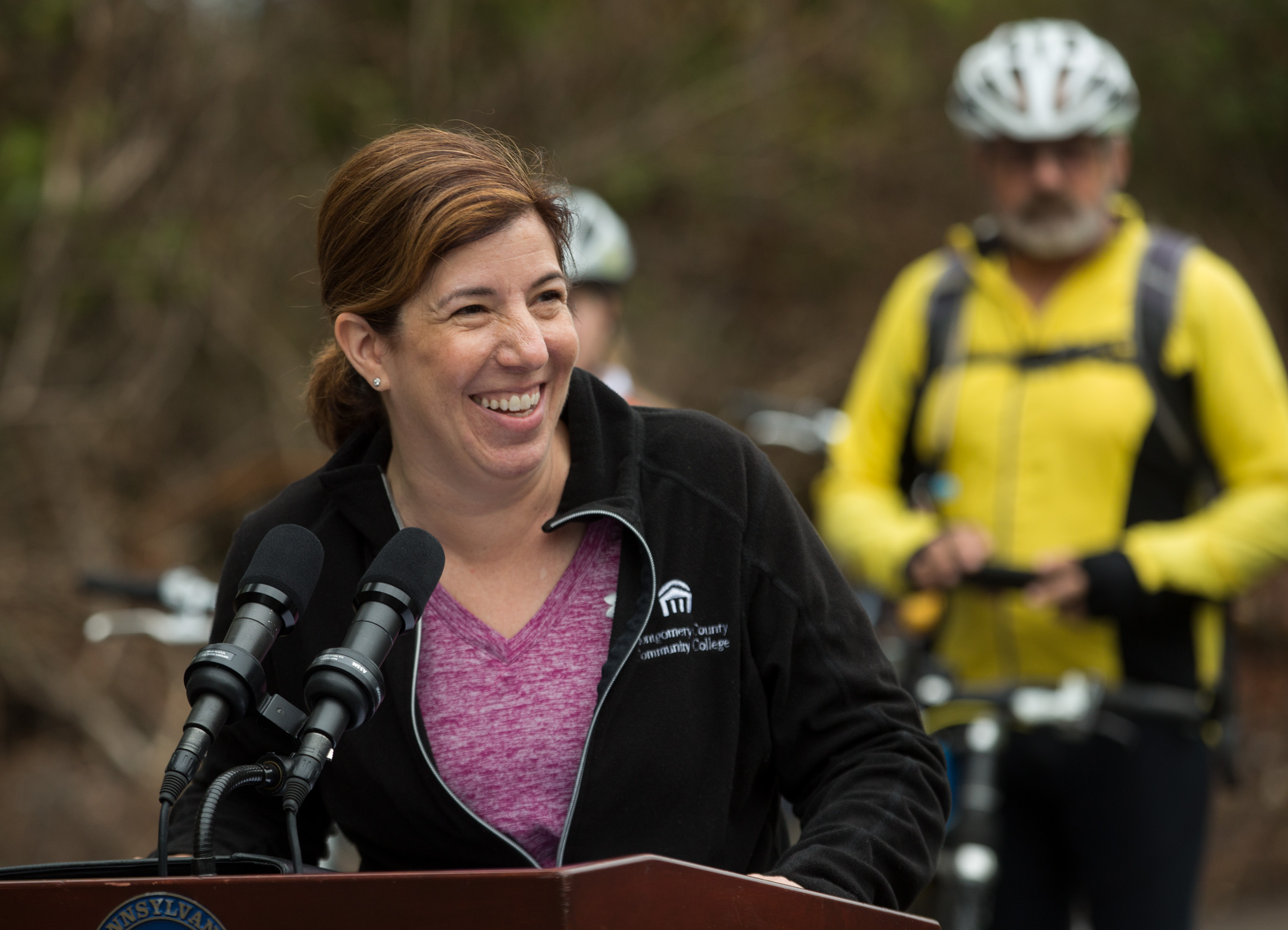 She was the first secretary to hire a dedicated Statewide Bicycle/Pedestrian Coordinator to champion multi-modal uses in highway projects. This led to adding shoulders for bicycles on roadways as well as adding sidewalks to projects where appropriate.
She was the first secretary to hire a dedicated Statewide Bicycle/Pedestrian Coordinator to champion multi-modal uses in highway projects. This led to adding shoulders for bicycles on roadways as well as adding sidewalks to projects where appropriate.
She championed aggressive outreach to small, minority, and women owned firms to provide opportunity for work on PennDOT projects.
She also approved the first multi-year, multi-million-dollar DVS capital improvement program to upgrade and modernize the many facilities for license renewals and testing across the state.
She created a Secretary Shadowing program where young women in the engineering and planning fields, both within the department and working for consultants, could spend a day with her on a normal meeting schedule.
Under Governor Tom Wolf's first term, Leslie proudly spoke of the Memorial for PennDOT workers (the traveling one and the one housed in the Keystone Atrium), the Innovation Challenge of High School Students, and PennDOT Connects – a new transportation-project approach.
Leslie says she misses the employees the most. "It was a wonderful place to work and really, they don't just care about the core mission of the agency, but also of each other!" she said.
WTS Pittsburgh and Central PA chapters had nominated her Woman of the Year 2018 and she was nationally recognized. And in 2019 she spoke on an international panel on Equity in Singapore.
If there was a regret, it was that she left too early. "I ran out of time," she said. "I wanted to get the memorial bridges names from the fallen where they worked or lived."
Secretary Barry Schoch
2011 to 2015
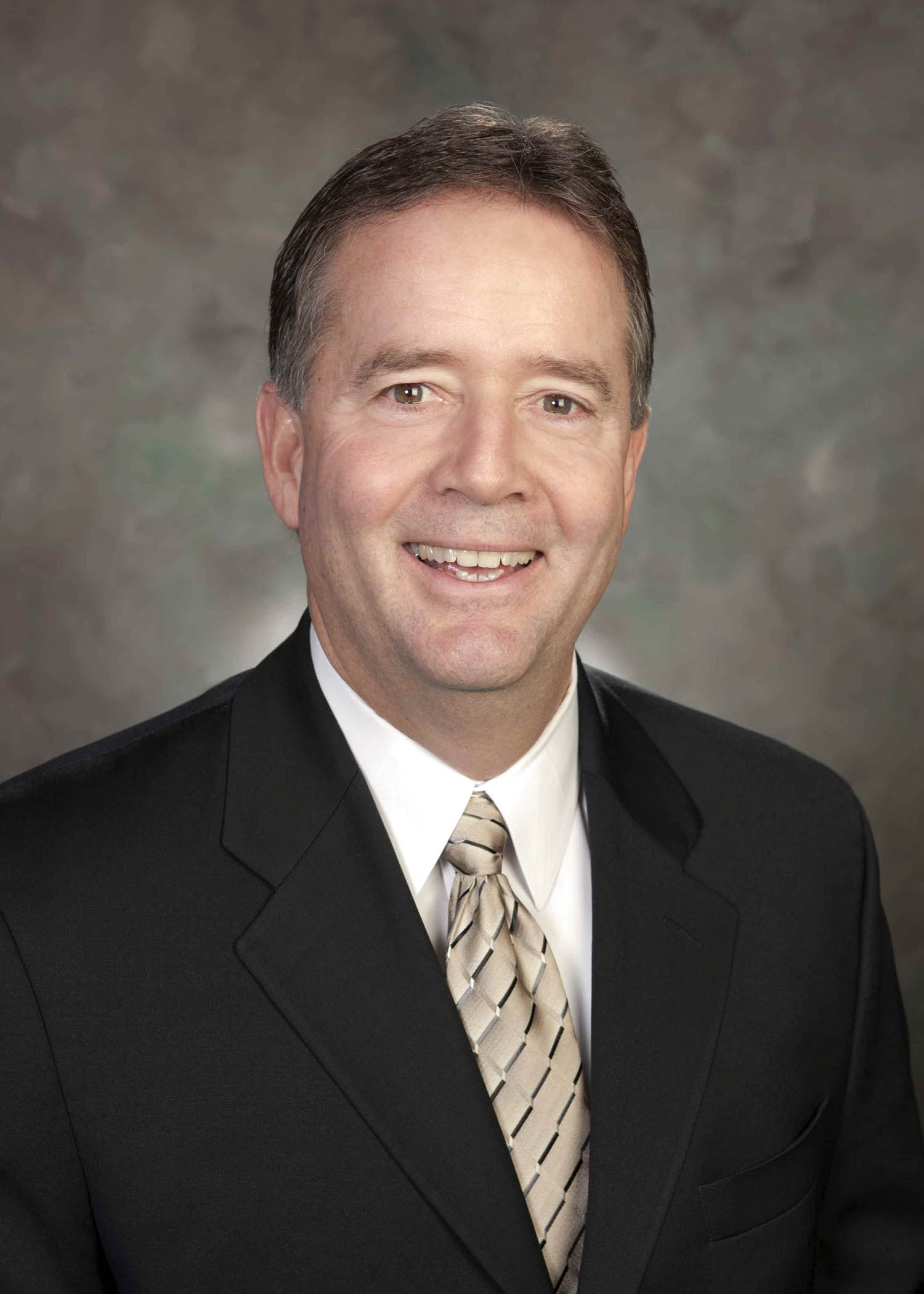 Barry Schoch worked in the private sector for years, but in 2011 when he was appointed Secretary of PennDOT, he got the inside scoop.
Barry Schoch worked in the private sector for years, but in 2011 when he was appointed Secretary of PennDOT, he got the inside scoop.
"I loved working with the people of PennDOT – inside the agency –they are so dedicated to their mission," said Barry.
Early on, he sought to harness that dedication and a new employee-suggestion system called IdeaLink was established so employees could submit ideas directly to decision-makers. There was other modernization, too. For example, the highway occupancy permit process was updated to streamline a process involving many paper forms and make it electronic. The project earned at least one national award during his service.
The landmark transportation-funding bill, Act 89 of 2013, was passed that made substantial investments in our infrastructure and also established a dedicated Multimodal Fund for non-highway modes. But Barry said his proudest moment while Secretary came in May 2013. Barry was out of town with then-Governor Tom Corbett when a fuel tanker caught on fire on the upper tier of a bridge above Interstate 81 in Harrisburg. No one was hurt, but the crash and ensuing fireball damaged roads and closed major routes for days.
"Our maintenance crew was on the site almost immediately. [Then District-8 Executive] Mike Keiser and his team were looking at the damage," said Barry. "That day, everyone worked together…Talented and committed people to assess and solve the problems."
There was significant agency and private-sector involvement and rapid mobilization to the site. There was a press conference that day to explain what happened, describe how we assessed the damage and our plan to deal with the long-term inconvenience. Multiple team members in central and district offices were coordinating, and we worked with the Pennsylvania Turnpike to facilitate traffic flow in the area while travelers adjusted to I-81 being shut down until it could safely be reopened. Barry indicated that the public had no idea how much went into solving these problems so quickly and what went into it.
He also mentioned another instance when PennDOT employees ensured public safety during tropical storm Lee and worked tirelessly on flood control. Barry was inspired by how dedicated the employees are to the PennDOT mission.
"They may do routine work doing their jobs, but when an extreme event occurs, that requires quick responses – they deliver," he said. "Everyone in their role. Extra hours – it doesn't matter what part of PennDOT you need – they are ready."
Barry saw the employees' commitment to their work and wanted to make the department a more-competitive employer as compared to the private sector. His tenure introduced Alternate Working Schedules (AWS) or flex working from home because he believed that employees needed to be treated fairly, not just through pay but flexibility.
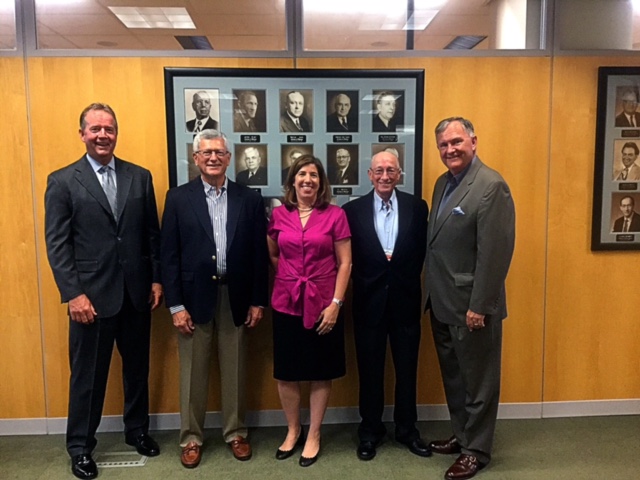
Former PennDOT secretaries. Left to right: Barry Schoch, Allen Biehler, Leslie Richards, Howard Yerusalim, Bradley Mallory
Secretary Allen Biehler
2003 to 2011
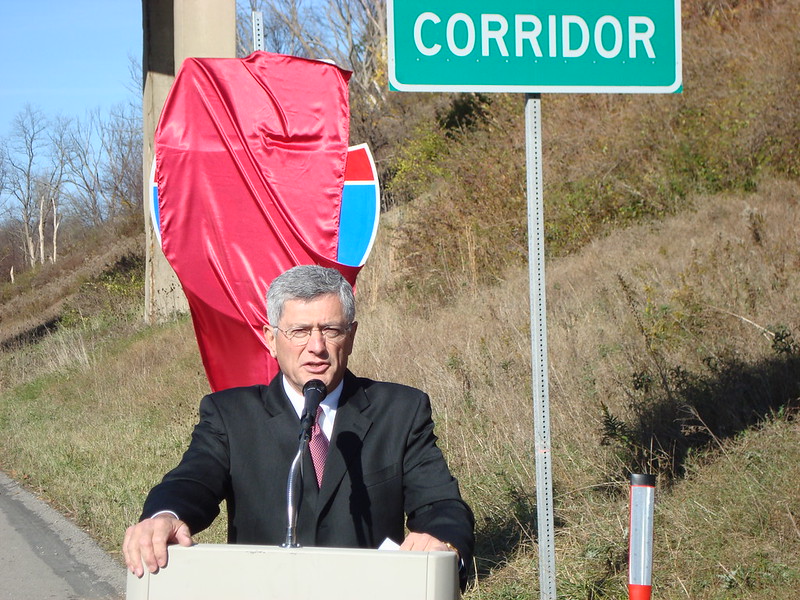
Allen Biehler came to the Department of Transportation with a broad experience in transportation as he had worked for the PA Department of Transportation, under former PennDOT Secretary Tom Larson (1979-1987). In addition, he had worked for the Port Authority of Allegheny County bringing with him planning, design and construction experience in public transportation. His tenure brought significant change to planning and funding of transportation projects in Pennsylvania while building on continuous quality improvement started by Tom Larson.
Under Governor Rendell's administration, Allen continued to improve our highway and bridge infrastructure by focusing on state of good repair projects. Of Pennsylvania's 40,000 miles of state-maintained roads, 11,000 miles of them were in poor shape and 5,000 bridges were deemed deficient. While prior emphasis had been on expanding the network and improving pavement smoothness, Allen's background in planning led him to make the hard decision to cancel and reevaluation many projects on the Twelve Year Program in 2004 that were not able to be constructed due to limited finances.
Allen believed that getting local involvement earlier in the process would improve the projects and make them more community focused. He led the development of the "Smart Transportation Design Guidebook" to integrate the planning and design of streets and roadways in a manner that fostered development of sustainable and livable communities. The design book was then incorporated into the PennDOT's Highway Design Manual.
Allen worked closely with other agency secretaries convening a joint conference that included DEP, DCNR and PennDOT and rural, urban, municipality officials to gather input on how to integrate land use, transportation and economic development in transportation projects. He offered a grant program called the Pennsylvania Community Transportation Initiative (PCTI) that focused funding on local community transportation projects. PennDOT received over $400 million worth of applications for the first-round funding of $60 Million and it could be considered the foundation of the current Multimodal Transportation Fund. PennDOT also changed the focus and worked closely with local municipalities, setting up programs for them to use funds and go through the environmental process.
He also convened and chaired the Transportation Funding and Reform Commission (TFRC) to examine transportation funding in Pennsylvania. The TFRC report released in 2006 proposed additional funding for highways and public transportation in PA and reforms to the program structure of public transportation. The recommendations became the basis for negotiations for what eventually became Act 44. Act 44 provided additional funding for highways and bridges, created a protected, restricted and stable funding sources for public transportation through the Public Transportation Trust Fund and gave the Department more oversight over public transportation in the Commonwealth.
One of Allen's most significant transportation accomplishments was the U.S. Route 202 Section 700 project. This corridor passed through multiple jurisdictions, including 11 members' districts and two Senators' districts and was debated for over 40 years. The new alignment was designed as parkway instead of a four lane highway keeping the speeds down and preserving the community nature by incorporating pedestrian and bike facilities. Secretary Barry Schoch finished the project during his tenure. The project demonstrated that local cooperation and community input could be successfully incorporated into our transportation projects.
Secretary Bradley Mallory
1995 to 2002
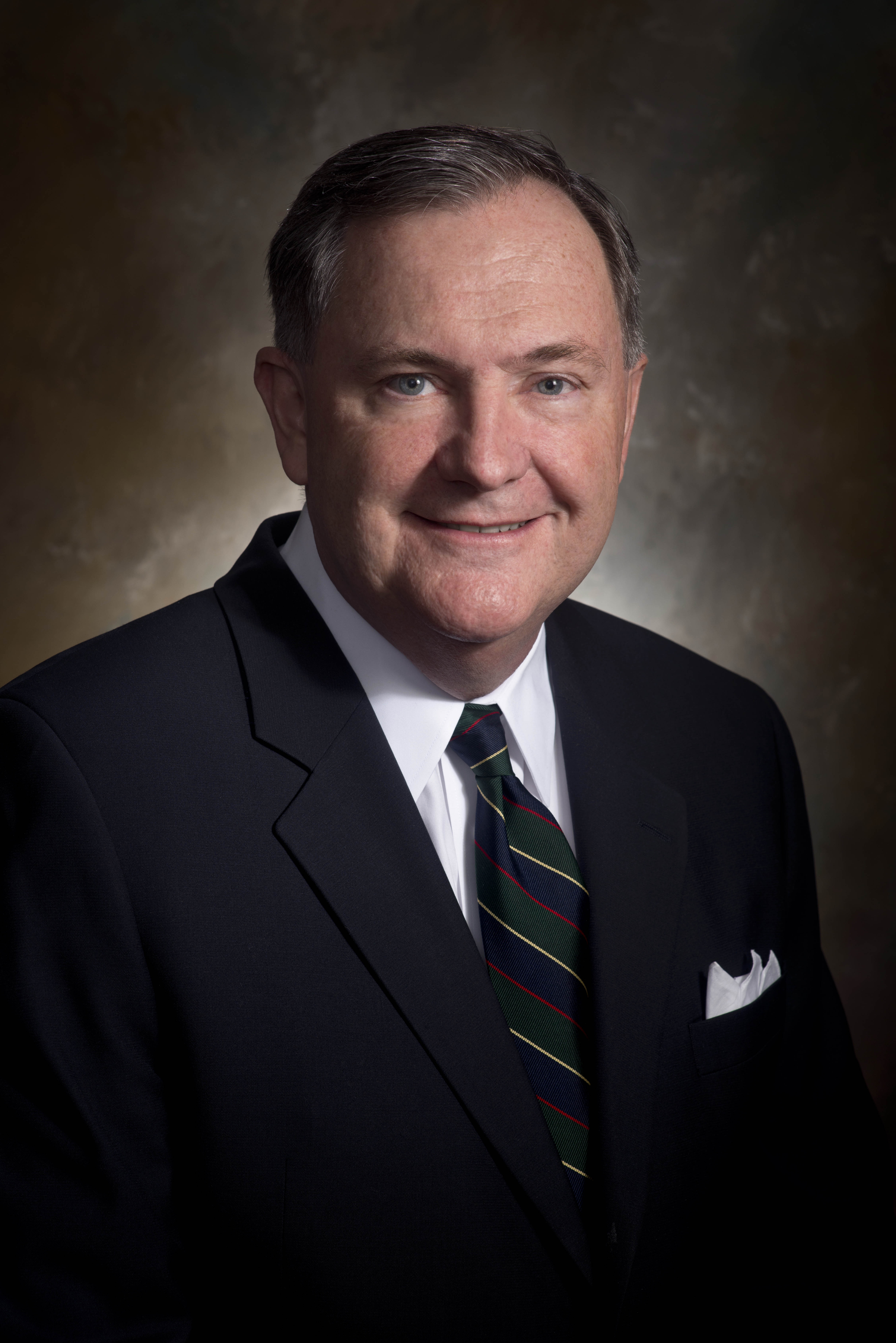 As Governor Thomas Ridge's Transportation Secretary, Brad Mallory was determined to promote a more realistic public impression of the dedicated service provided by department employees. Drawing upon his experience in a variety of PennDOT leadership positions, Secretary Mallory embarked on an outreach campaign that included regular press conferences to share the PennDOT story.
As Governor Thomas Ridge's Transportation Secretary, Brad Mallory was determined to promote a more realistic public impression of the dedicated service provided by department employees. Drawing upon his experience in a variety of PennDOT leadership positions, Secretary Mallory embarked on an outreach campaign that included regular press conferences to share the PennDOT story.
Brad Mallory had a long relationship with PennDOT before and after serving as Secretary. As the Assistant Attorney General, he was assigned to PennDOT in 1977 and worked in Hazardous Substances Division; Highway Safety; Strategic Planning; and then, Rail Freight, Aviation and Economic Development before being appointed Secretary in 1995. He served in that role for 8 years under Governor Tom Ridge, then Governor Schweiker when Ridge became Homeland Security Director.
"My favorite part while serving as Secretary was the people I worked with. I did a lot of outreach, both to the public and our employees," said Mallory. Each week Mallory participated in a press conference or two.
While in office, it was the first time Pennsylvania pavement smoothness exceeded the national average. Another achievement was the customer service revolution in Driver and Vehicle Services.
The Blizzard of 1995-96 happened under his watch, too. "PennDOT saved the state," said Mallory. "I'm really proud of the work we did then. It was quite the undertaking!"

Former PennDOT Secretaries at lunch. Left to right: Barry Schoch, Brad Mallory, Leslie Richards, Howard Yerusalim, Allen Biehler
Secretary Howard Yerusalim
1987 to 1995
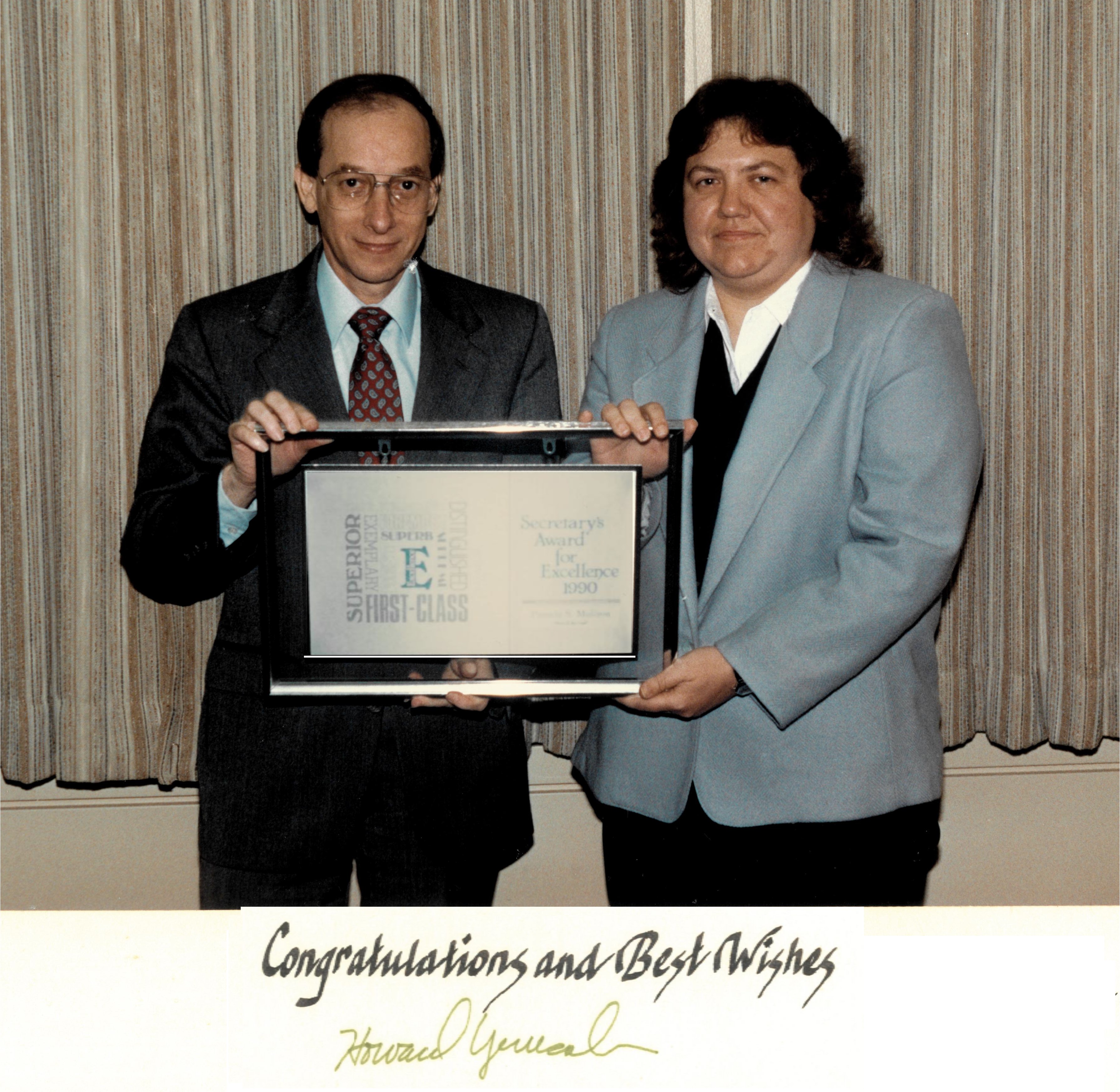 In 1987, Governor Robert Casey appointed Howard Yerusalim as agency head with the confidence that PennDOT would build upon the successes of the Larson years. Secretary Yerusalim came to the job with many years of PennDOT experience in managing engineering, planning and administrative tasks. Having spent the past 4 years as the Deputy Secretary of Administration, he had been at the forefront of department initiatives to promote employee involvement. Agency employees joined this next phase of PennDOT's "quality journey" in a team effort to complete interstate highways and to advance multimodal programs.
In 1987, Governor Robert Casey appointed Howard Yerusalim as agency head with the confidence that PennDOT would build upon the successes of the Larson years. Secretary Yerusalim came to the job with many years of PennDOT experience in managing engineering, planning and administrative tasks. Having spent the past 4 years as the Deputy Secretary of Administration, he had been at the forefront of department initiatives to promote employee involvement. Agency employees joined this next phase of PennDOT's "quality journey" in a team effort to complete interstate highways and to advance multimodal programs.
The selection of former Secretary Larson as Federal Highway Administrator in 1989 strengthened the state-federal partnership that had developed over the past 10 years. This partnership enabled PennDOT to resolve difficult engineering, environmental, and financial issues for the completion of major Interstate highway sections in urban areas. To avoid the type of large-scale borrowing that had crippled the highway budget in the 1970's, bond issues were approved only for limited and targeted purposes. Most pressing was the need to move on Interstate projects before the federal government placed a cap on its total funding commitment. Identifying an innovative financing provision in federal law, PennDOT gained state legislative approval for borrowing that accelerated the construction schedule and obtained federal dollars to help offset debt repayment of the state project share. A second targeted borrowing was for highway access to the Greater Pittsburgh International Airport that opened in 1992. This multimodal project was part of the strategy to diversify the area's economy after the collapse of the steel industry.
A recurring theme in PennDOT's history is the reality of limited resources to address the maintenance needs for Pennsylvania's extensive highway network. During the Larson years, priority had been given to low level treatments that "keep the water off the road" to prevent further deterioration. As the financial situation stabilized, highway maintenance crews began to perform more durable pavement treatments to address the backlog of deferred maintenance needs. With persistent attention to productivity and employee involvement, maintenance crews in the 67 county organizations achieved steady progress toward providing the public with more acceptable road conditions.
Further supporting this effort were Highway Maintenance Administration personnel who participated in the Strategic Highway Research Program (SHRP), which was a collaborative effort led by the Federal Highway Administration, the American Association of State Highway and Transportation Officials and the Transportation Research Board. This research project led to the introduction of Superpave, a superior performing asphalt pavement mix for which Pennsylvania became a leader in its adoption at the state level. Other features of the initial 6-year SHRP study were concrete mix design, highway operation, and long-term pavement performance. This partnership coincided with PennDOT's quality journey to provide more cost-effective practices for durable pavement preservation, work zone safety, and winter traffic services.
Leadership continued to encourage department staff from all deputy areas to become more active role on the national scene. PennDOT employees became prominent contributors to national organizations representing systems and services in all transportation modes, as well as planning and administrative functions. In these and other national forums, this involvement had the dual benefit of enriching PennDOT's knowledge base while enhancing the department's reputation.
Secretary Thomas Larson
1979 to 1987
Tom Larson had come to the attention of Governor Thornburgh as the co-founder and first director of the Pennsylvania Transportation and Safety Center at Penn State University. Upon appointment as Secretary, Dr. Larson moved quickly on his commitment to implement best practices and to a vision of "New Directions for PennDOT." He assembled an energetic and innovative leadership team and encouraged the development of talented individuals throughout the agency.
The most immediate challenge was to address highway maintenance operations. Historically, highway maintenance employees had been selected by county political party chairmen, who also held significant influence over day-to-day operations. To improve productivity and quality control, PennDOT gained support to replace the patronage system with merit-based hiring and centralized control over operations. Under Dr. Larson, PennDOT became one of the first public transportation agencies to adopt strategic management with its emphasis on program planning and performance measures. Planning functions were recast under the Center for Program Development and Management to focus on results-oriented plans that directly supported the expectations for service delivery units. A new organization was created to establish and monitor a set of agency, district and county measures that set targets and monitored progress for the highest priority activities.
By 1982, PennDOT was recognized as national leader among public works agencies and Secretary Larson was named "Man of the Year" by Engineering News-Record. As policies and procedures continued to improve and were more uniformly applied by the department's highway and non-highway units, PennDOT pursued every more challenging stretch targets and was successful in delivering better program results. With the turnaround in PennDOT's public reputation and internal confidence, the agency expanded customer service and employee involvement initiatives that were becoming more prevalent in the private sector. Quality Circles and other mechanisms were established to encourage employees to analyze their operations and suggest ways to improve the efficiency and effectiveness of transportation services for Pennsylvania residents.
In 1986, construction of a new passenger terminal building was completed at Harrisburg International Airport, which the department owned and operated until 1998. The new facility replaced an aviation hangar that had been repurposed after the Olmsted Air Force Base was closed at the end of the 1960's and transferred to state ownership. To ensure that the new terminal was in top condition for opening day, Secretary Larson led a team of volunteers from central office to sweep floors, clean countertops, and dust light fixtures. This was just one example of the dedication and can-do spirit exhibited by employees at all levels in all organizations within PennDOT throughout its 50-year history.
During a period in which state legislatures around the country were showing more reluctance to raise taxes, PennDOT's accomplishments led to a series of incremental motor fuel tax increases. The priority for additional funds was to provide more adequate budgets to county highway maintenance organizations. With this support from the General Assembly, Pennsylvania also was able to provide sufficient state match to avoid the loss of federal funds and to leverage the 90% federal share available for Interstate highway construction.
The Early Years: Secretaries Victor Ankietus, Jacob Kassab, William Sherlock, James Wilson and George Pulakos
1970 to 1979
PennDOT was created in 1970 through legislation signed by Governor Raymond Shafer as part of an effort to reorganize and streamline government agencies to better deal with the rapid economic and social changes in the decades following World War II. The immediate challenge for leadership and employees was to consolidate programs from a half dozen agencies into a single PennDOT team. Secretary Victor Ankietus became the first Secretary and served briefly before the election of Governor Milton Shapp and his appointment of Jacob Kassab in 1971. Pennsylvania's had and continues to have one of the most extensive networks of state-owned roads and bridges, making Highway Administration the largest deputy area with offices throughout the Commonwealth.
Having developed a high level of engineering expertise, PennDOT continued to move aggressively in the early 1970's to advance Interstate and other major highway projects. During this same period, department staff created new programs to address the public transit, rail freight, aviation and waterway needs that established the foundation for future efforts to strengthen the contribution of each of these modes of transportation. Legislation authorizing free rides for senior citizens on fixed transit routes was particularly noteworthy as a strategy to improve mobility for older Pennsylvanians while supplementing transit agency revenues. In driver and vehicle services, staff achieved significant efficiencies through merging of revenue collection into the registration and licensing process.
During the emergency disaster response to flooding from Hurricanes Agnes in 1972 and Eloise in 1975, PennDOT demonstrated its ability to manage through crisis conditions and to rely on dedicated maintenance workers to restore transportation services. This legacy of admirable performance in battling blizzards and floods has continued throughout the Department's 50-year history. News organizations in every region of the Commonwealth have commended PennDOT maintenance teams for their extraordinary work and have reported on heroic actions in the face of extreme weather events.
When Secretary Kassab retired at the end of 1975 and was replaced by William Sherlock, PennDOT was faced with daunting challenges. Oil embargo, rising gasoline prices, and a faltering economy had interrupted the steady growth of vehicle ownership, miles of travel, and highway revenue that followed World War II. Burdened by debt repayment for roadbuilding projects and with limited financial resources, thousands of employees had to be furloughed to continue with a minimal level of basic operations. In 1977, Secretary Sherlock and 6 other PennDOT employees died in a plane crash while traveling to a northcentral Pennsylvania public transit event. The Keystone Building in Harrisburg houses memorials to these individuals and to the hundreds of other department employees who have died in the line of duty. By the time Secretaries James Wilson and George Pulakos had completed their tenure under the Shapp Administration, PennDOT had become a major issue in the gubernatorial campaign that led to the inauguration of Richard Thornburgh in 1979.